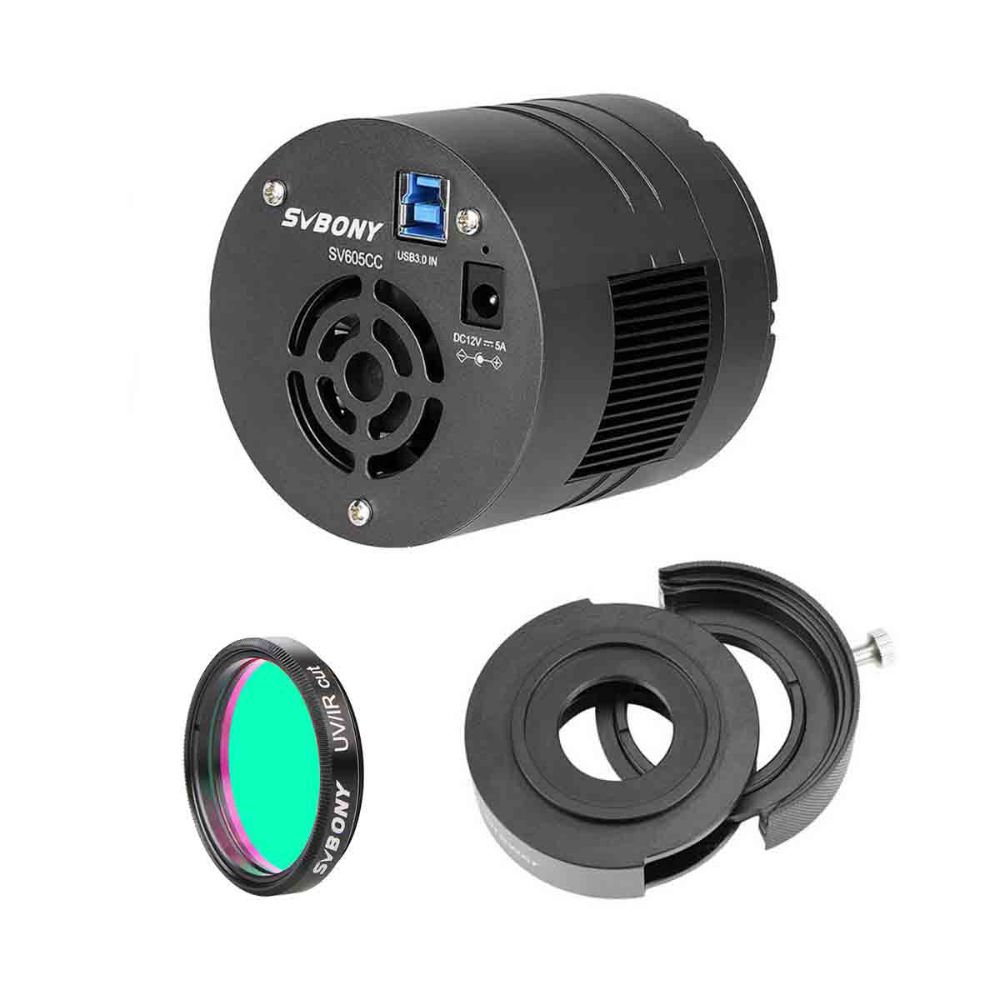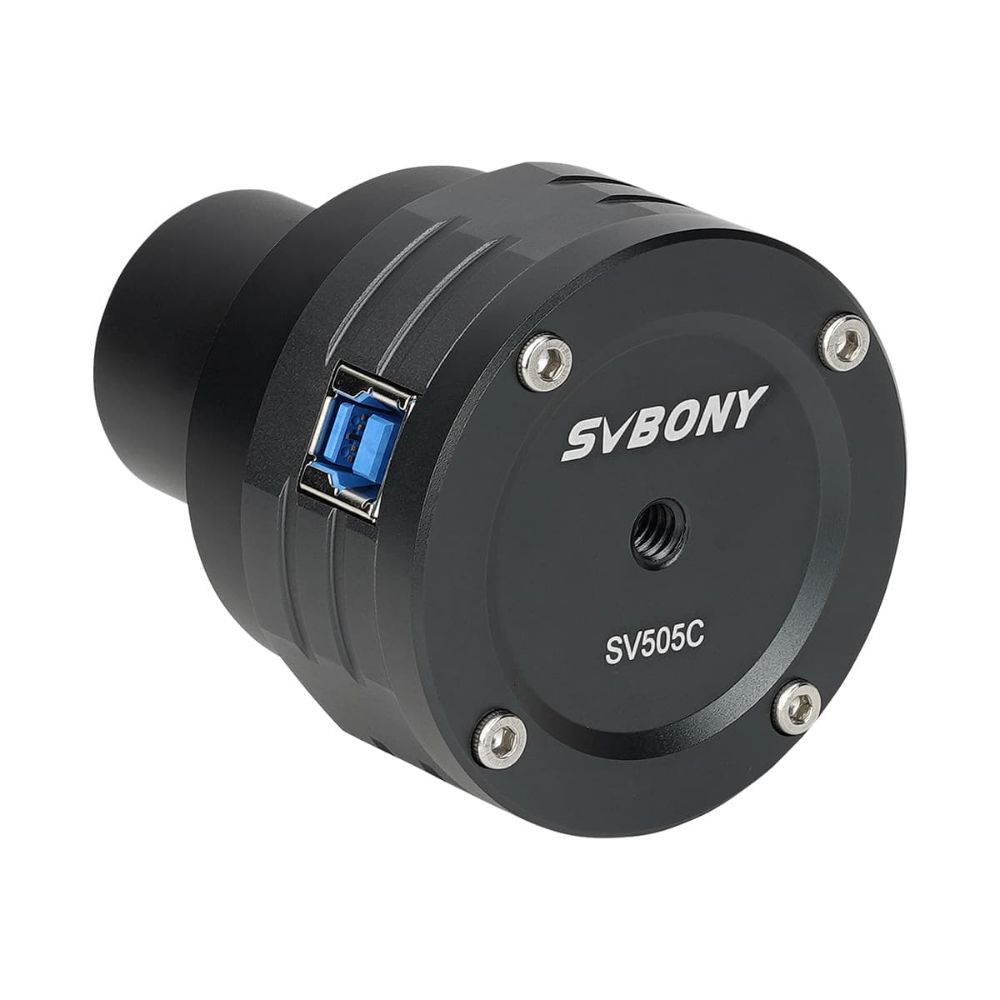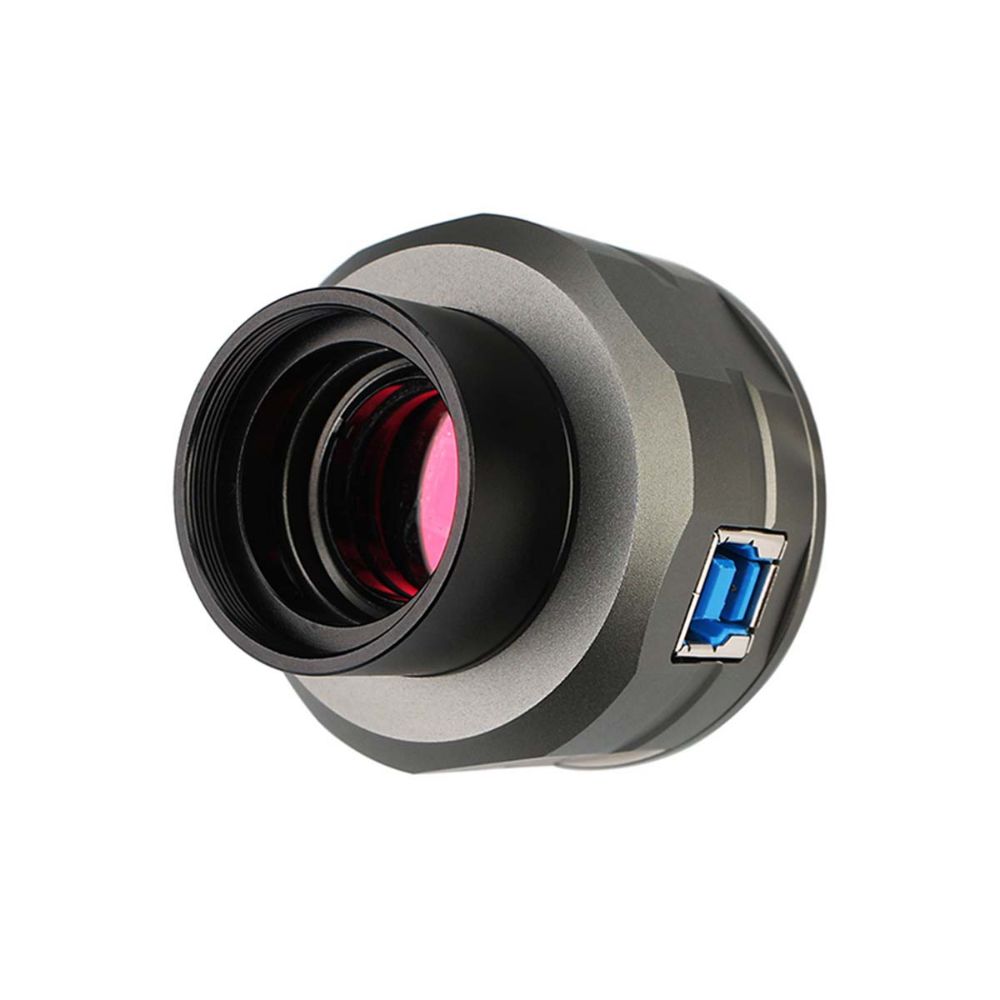CMOS Cameras
SV605CC
- SV605CC is a 1-inch color deep space camera with square frame, 3.76um pixel size, better resolution and 80%+quantum efficiency. It can get good imaging in light polluted environment with double narrowband filters;
- IMX533 color 1-inch chip: The glow of CMOS will affect the signal-to-noise ratio of the glow affected area, resulting in residual glow or reduced signal-to-noise ratio of the area. IMX533 achieves glow suppression and better shooting effect;
- With a short focus mirror or a fast mirror system: Even if the target is too small, more details cannot be obtained due to the analytical force; IMX533 chip uses 3.76μm pixel; easy to analyze 10 angle split field of view;
- Cooling System: Thanks to the two-stage TEC cooling, the SV605CC can lower the CMOS sensor temperature to 30°C below amboent temperature, which can greatly reduce dark current generation and sensor noise even during longer exposure times.
- Support system: SV605CC camera works with Windows, Linux, Mac OS, Chrome OS and Raspberry Pi systems by running AstroDMx Capture. For Windows system, also support Sharpcap, N.I.N.A, TheSkyX and other softwares run throuth ASCOM platform by suing ASCOM driver;
- The Bayer Pattern of SV605CC is GRBG.
Note: The SV605CC has completed the product change to optimize the horizontal stripe, and the S/N serial number of the new product has been changed to S/N(B).
SV405CC
- SV405CC cooled color astronomy camera for deep sky astrophotography. The deep space shooting targets are mainly nebula, galaxies, star clusters, multiple stars, etc;
- IMX294 color CMOS sensor; The IMX294 sensor adopts the 4/3 format and provides the necessary number of pixels for true 4k output at 120 frames per second;
- USB 3.0 high-speed interface; The bandwidth of up to 5GB allows the camera to run at 19 frames per second in raw8 mode and 16 frames per second in raw16 mode at full resolution of 11.7 million pixels;
- Cooling System; Thanks to the two-stage tec cooling, the camera can lower the CMOS sensor temperature to 86°F below ambient temperature, which can greatly reduce dark current generation and sensor noise even during longer exposure times;
- Support system; Compatible with Windows, Linux, Mac OS, Chrome OS and Raspberry Pi systems by running AstroDMx Capture. For Windows system. Also support Sharpcap, N.I.N.A., TheSkyX and other softwares run through ASCOM platform by using ASCOM driver;
- The Bayer pattern of the SV405CC is GRBG
SC432M
- Global shutter; SC432M telescope camera is a global shutter camera; features a 120 high frame rate per second;
- Large pixels; SC432M camera pixel is 9μm x 9μm; with its high sensitivity; images with finer colors and subtler details are possible;
- 1.1" frame; SC432M astrophotography camera has a 1.1" large format; a larger field of view; and a larger area than currently recognized planetary cameras; provide clear imaging details; reducing the number of post-processed images;
- Fan cooling; connected to an external 5V1A power supply; type-C power supply; which can lower the camera temperature by 5-10 degrees; long exposure reduces noise and ensures the quality of the picture;
- HCG; turn on HCG mode when the gain value is 140; the readout noise can be greatly reduced and high dynamic range is retained; avoid celestial tailing and increase celestial details.
SV705C
- SV705C telescope camera is not only for planetary imaging, but also super well for EAA (Electronically Assisted Astronomy) and nebula Imaging;
- IMX585 CMOS color sensor; Compared with IMX485, it produces up to 45 fps with super low readout noise. It also increases the sensitivity by approximately 1.7 times compared to IMX485. IMX585 has 3 times the number of full well charges, and has a very high signal-to-noise ratio;
- 1/1.2-inch frame, a pixel size of 2.9μm*2.9μm, a maximum resolution of 8.30 Mega Pixel (3586*2180), an imaging area of 11.2mm×6.3mm, and a diagonal of 12.85mm, which can obtain rich celestial details;
- The near-infrared sensitivity is 1.7 times that of the previous generation; which can greatly improve the near-infrared shooting efficiency and capture more details of celestial objects under the same exposure time;
- Dual-gain HDR; which still retains a very high dynamic range at high gain; about 8 times that of the previous generation; which can greatly reduce the read noise;
- Based on the back-illuminated sensor and advanced pixel technology; the SV705C's full well charge can reach 38ke; the peak QE of SV705C can reach about 90%; you will get the better image quality;
- The front end of the camera is a CS port; and is also equipped with a C-CS adapter ring; which can be used with C-mount lenses and CS-mount lenses to make time-lapse video; with a fisheye wide-angle lens; it can be used for all-day.
SV305M Pro
SV305M Pro Astronomy Camera, 2MP USB3.0 1.25 Inches Monochrome and Guide Camera for Astrophotography
- Get a sharp image; uses an extremely sensitive CMOS monochrome sensor; the IMX290LLR-C; which has very high QE (80%); very low readout noise (1.0-3.2e); pixel size 2.9um; 1944*1096 pixels resolution; 6.46mm diagonal;
- Has a stable transmission; built-in 128MB DDRII image buffer; cache the image and transfer it to the computer when the USB interface is not busy or being interrupted; get a sound frame; allows a slower computer with USB 3.0; to capture every frame ;
- Improve camera sensitivity; has ROI and BIN functions; any resolution can be set; could read a smaller region of interest (ROI) out from the sensor; leaving the image scale of the object being imaged unchanged; greatly increase the camera rate; BIN2*2 pixel can merge two adjacent pixels; which can improve camera sensitivity;
- Can automatically guide; designed with ST4 guiding port; supported by PHD2 and the ASCOM platform; use the computer to control the telescope; has an auto-guiding port; which connects directly to the auto-guider; which usually referred as an ST-4 port; works with analog signals;
- Good transformation performance; using USB3.0 high speed data transmission; quick and efficient for planetary imaging.
SV505C
- At full resolution, the camera frame rate of SV505C can reach 93fps, and more frames can be captured at the same time. Especially in the case of bad weather, the shooting can be completed quickly by using the shooting gap time;
- SV505C has a QE of about 80%. It has extremely high sensitivity in the near-infrared region and extremely high signal-to-noise ratio in the dark environment. It is very suitable for photographing the surface details of Mars, Jupiter, Saturn and other solar system planets and the moon. The camera has extraordinary sensitivity in the infrared band;
- The SV505C has a 1/1.8" frame, and the chip area is 7.9mm x 4.5mm, which means that the photosensitive area is almost twice that of the sv305 pro. With the same telescope, a larger area can be photographed.
SV205
- Svbony SV205 with SONY IMX415 CMOS sensor and USB3.0 Type-B port. It complies with the standard UVC protocol and no need to install SVBONY driver. It is the plug and play device, suitable for beginner users for astronomy photography;
- The image sensor uses dark light compensation technology to greatly improve the camera's image clarity in low light conditions;
- In MJPG video format;you can record video quickly and the frame rate up to 30FPS at 2K resolution 1920x1080; You can also choose YUV uncompressed video format;
- The camera allows you to capture a real-time video and transport to your laptop or PC;machined aluminum 1.25" adapter barrel for direct threaded connection to almost any telescope.











